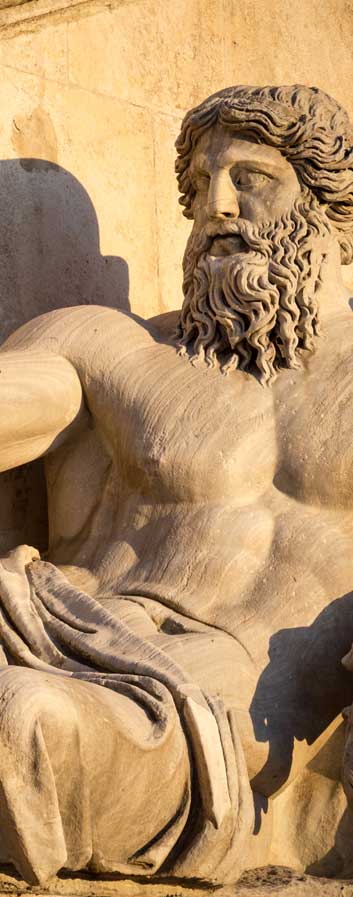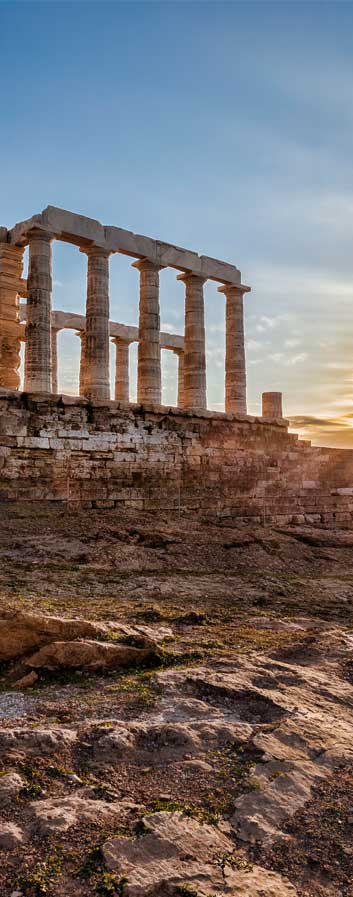Madaba Mosaic Map
The most important geographic mosaic of the byzantine era was discovered in Madaba, a small village 30 km to the south of Amman, in December 1896. The map adorned the floor of a church situated close to the city's North Gate. When discovered, what remained of the map were a large section in the central and southern aisles together with three isolated fragments laying between the first and third row of columns beyond the presbyterium. Originally the whole composition was not much larger than the extant dimensions of what has remained: resulting in a rectangular panel which is 15.70m by 5.60m at its maximum.
The over 150 captions in the Map, most of which have been positively identified, refer to localities of the Near East extending from Tir and Sidon to the north up to and including the Nile Delta to the south, and from the Mediterranean Sea to the Arabian Desert. Apart from this the physical characteristics of Palestine are so realistically rendered as to make them easily identifiable. Upon the central axis, formed by the flow of the Jordan River and the Dead Sea, there extend the trans-jordanian plateau with its deep valleys (wadi) to the east, and to the west the mountains of Samaria and Gudea distinctly separated by the Mediterranean coastal plain.
The map is oriented to the east, as are the cities and buildings therein represented as well as the captions accompanying them. As one made his way to the altar he could see and read all. Notwithstanding the unavoidable approximations, due to the limited space available, it is obvious that the disposition of the localities followed the road network prevailing at the time in the region. The localities are represented by a vignette and a caption.
The way the locality is represented gives an indication of its importance: Jerusalem, Neapolis, Ascalon, Gaza and Pelusium are distinguishable from minor cities the like of Kerak, Lod, Iabneel, Ashdod, Eleutheropolis, smaller towns of a certain importance such as Jericho, Bet Zachar, Bersabea down to mere symbols such as a gate with lateral towers or simply a church representing a village or shrine.
Apart from the rivers, the sea and mountains, the mosaicist used other symbols which are easily understood: palm trees that go with the oases in the Jordan Valley, bushes along the river banks, the fording places of the River Jordan with the characteristic pulley-drawn ferries, fish represented in the water and the two ships figured in the Dead Sea. More important, from the historical point of view, are the very particular indicative details used for certain localities, like the Twelve Stones placed in the walls of the church at Galgala, Jacob's well at Sichem, the baptism font/pool at Philippi near Bethzur, the terebinth or oak tree at Mambre, the pools at the spa of Calliroe, the configuring of Kerak as a fortress-city isolated upon a mountain.
The representation of Jerusalem reaches the apex of the art of representation in this mosaic. In a certain way the City is the ideal centre of the whole composition even if it is not physically situated in the centre of the map. The bird's eye view of the city is shown with its walls, gates, streets and major buildings which are partly identifiable even today.
From the geographic history point of view, the map owes its originality to these details. As to the rest of the contents it owes its sources to an antique journey diary, updated to cater for the needs of VI century christian pilgrims who visited the Holy Land, with the Bible at hand. This can be clearly seen from the preponderance of churches and shrines over other public buildings. From the artistic point of view, the Map must be viewed in the context of a return to the classical style prevailing in the Justinian epoch (half way through the VI century), of which the mosaics of Madaba and its surrounding region have given us many a dated witness.
The contents of the captions, especially the direct references to the tribes of Israel, names, quotation of biblical benedictions, clearly indicate that the Map is primarily a document of biblical geography based on the Onomasticon of Biblical Locations by Eusebius (IV century). The Map therefore covers the territory of the 12 biblical tribes and the surrounding regions, defined, as it were in the boundaries of Canaan promised to Abraham.
The addition of places mentioned in the New Testament, and the primary importance given to christian shrines, churches and to the Basilica of the Holy Sepulcher makes of the map a christian re-reading of the story of salvation in a geographic context. The Holy City of Jerusalem is represented at the centre of the redeemed ecumene, and the building which is given the greatest importance is the constantine complex built upon Calvary and Jesus' Sepulcher.
The christians living in the mid-VI century conceived and brought to conclusion this map in the church at Madaba. Seen in this perspective, the map is a witness to their faith.


































